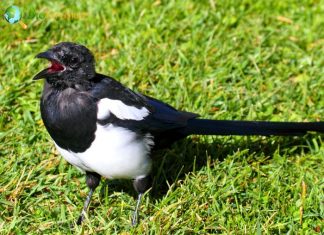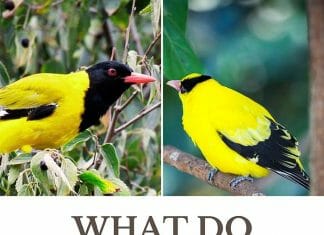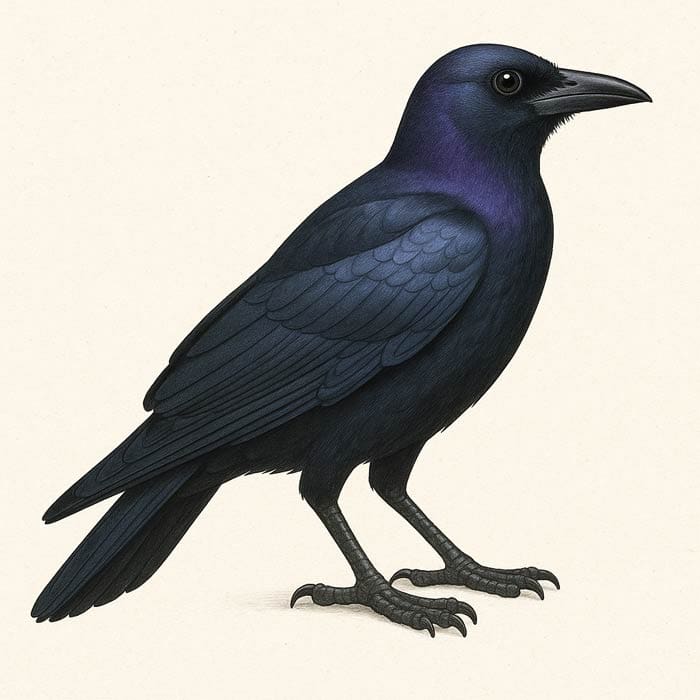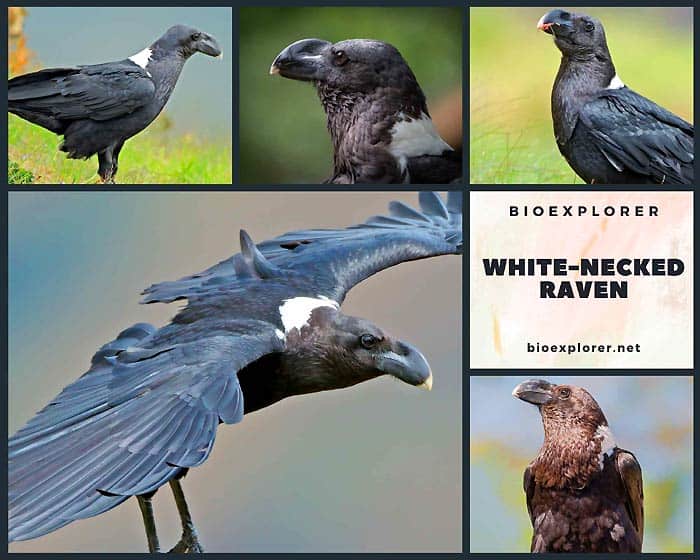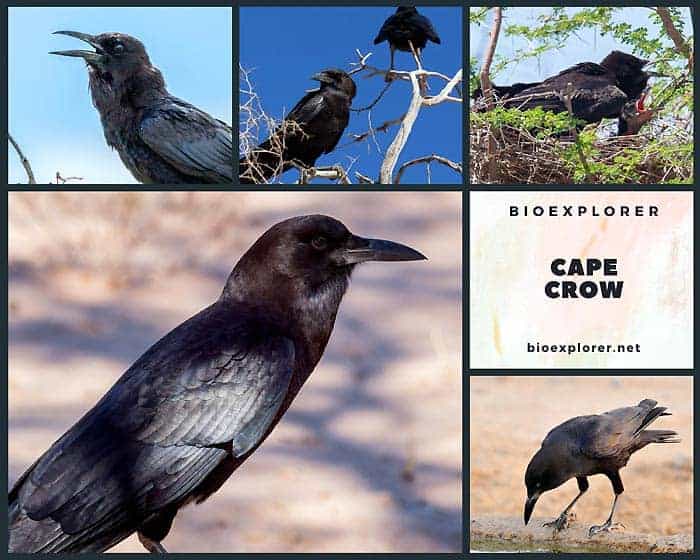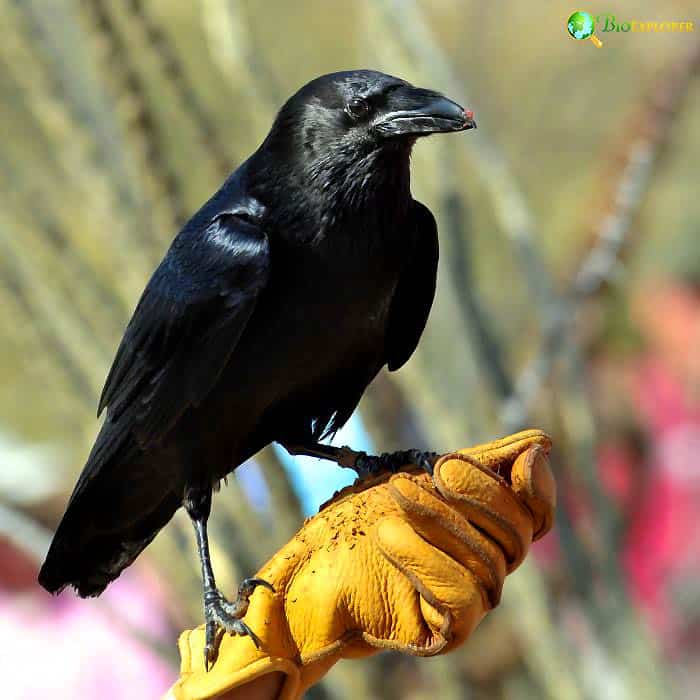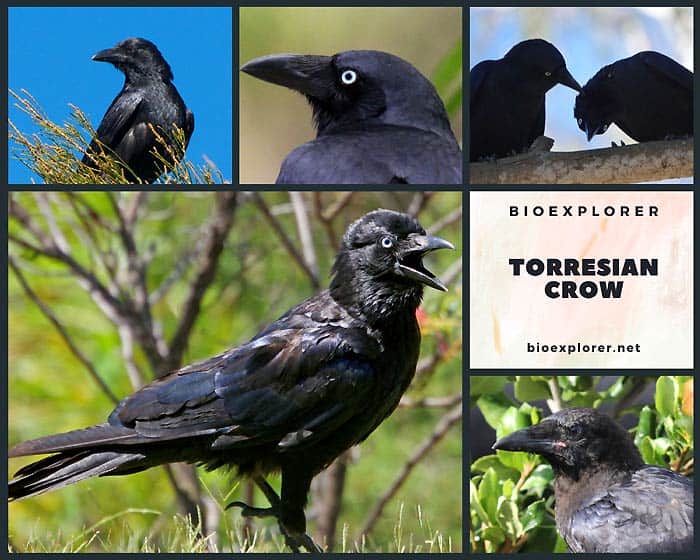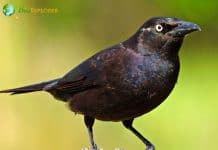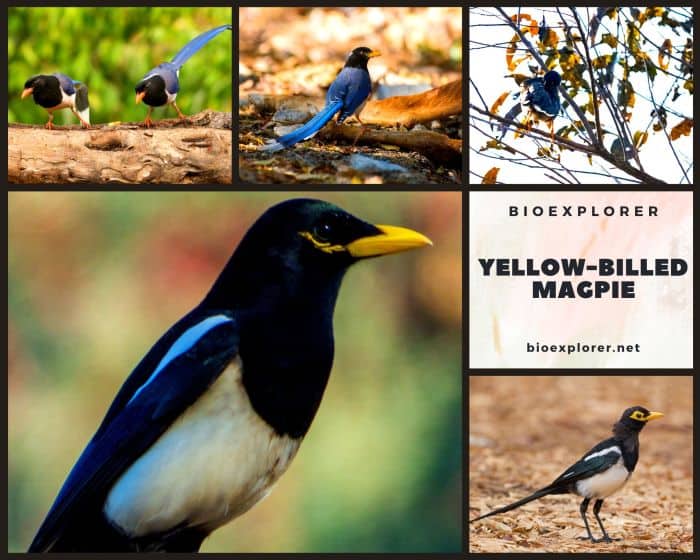
| Animalia | Aves | Passeriformes | Corvidae | Chordata | Pica nuttalli |
The Yellow-billed Magpie (Pica nuttalli) is a vibrant and lively Bird Species endemic to California, making it a unique and special part of the state’s avian diversity. It is characterized by its bold and striking appearance.
This boisterous bird is commonly found in open oak woodlands, thrives, and stands out with its distinctive colors. The Yellow-billed Magpie showcases contrasting hues, including black, white, shimmering blue-green, and yellow[1], creating a captivating sight for observers.
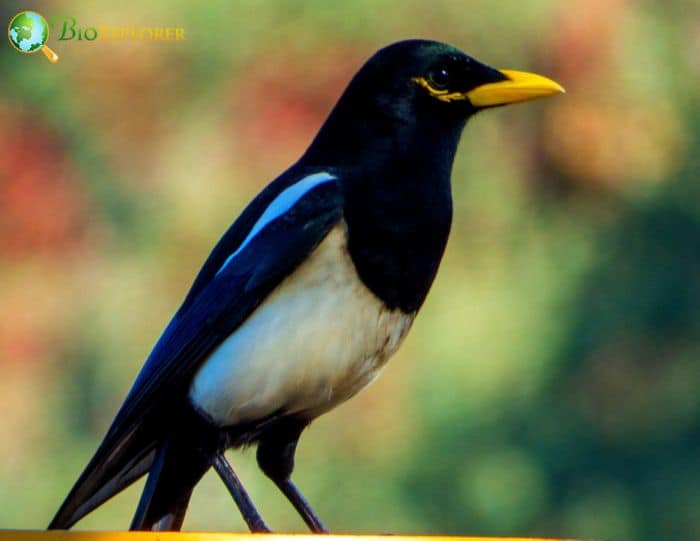
While it is fairly common throughout central California, from Redding in the north to Santa Barbara in the south, its highest concentration is observed in the Central Valley. This region provides an ideal habitat for the Yellow-billed Magpie as the oak woodlands seamlessly blend with plains, orchards, and agricultural fields, offering diverse resources and nesting opportunities.
With its energetic nature and conspicuous presence, the Yellow-billed Magpie adds liveliness and charm to the open oak woodlands of California. Its striking plumage and lively behavior make it a fascinating bird to observe and appreciate in its natural habitat.
![]()
Table of Contents
Yellow-billed Magpie Physical Characteristics
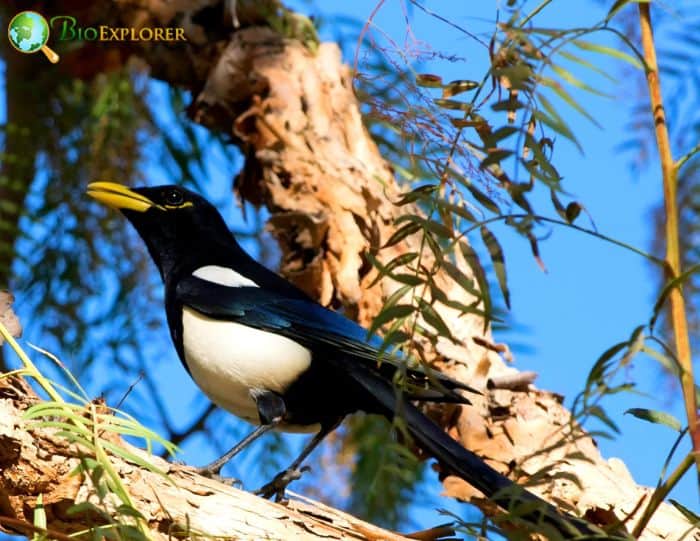
This large black bird has a 2-feet wingspan, making it an impressive sight in flight. It has a substantial presence in its habitat, with a length ranging from 18 to 20 inches.
- The Yellow-billed Magpie is adorned with a striking black plumage covering its head, chest, belly, and back. These dark feathers contrast starkly against the broad white patches that adorn its sides, adding a touch of elegance to its appearance.
- One of the most fascinating features of the Yellow-billed Magpie is its iridescent wings and tail. When catching the sunlight, these feathers shimmer in a mesmerizing display of blue, green, and white[2], adding a touch of brilliance to its overall look.
- As its name suggests, the Yellow-billed Magpie boasts a vibrant yellow bill that stands out against its dark plumage. This unique feature and its long blue tail further enhance its visual appeal.
- The bird’s shiny eyes, surrounded by the bright yellow of their bills, add a touch of liveliness to its countenance. Although the yellow marking around the eyes may sometimes be challenging, it adds a distinctive touch to the Yellow-billed Magpie’s appearance.
Suggested Reading:
Black-billed Magpie
Species Name: Pica hudsoniaYellow-billed Magpie mode of communication
Calls and grunting noises are magpies’ main forms of communication. These birds have a fluty sound, and the yellow-billed blue magpie has a loud call. They can remember humans and are friendly birds. Even interactions with humans are remembered by them.
Yellow-billed Magpie possesses a gregarious instinct
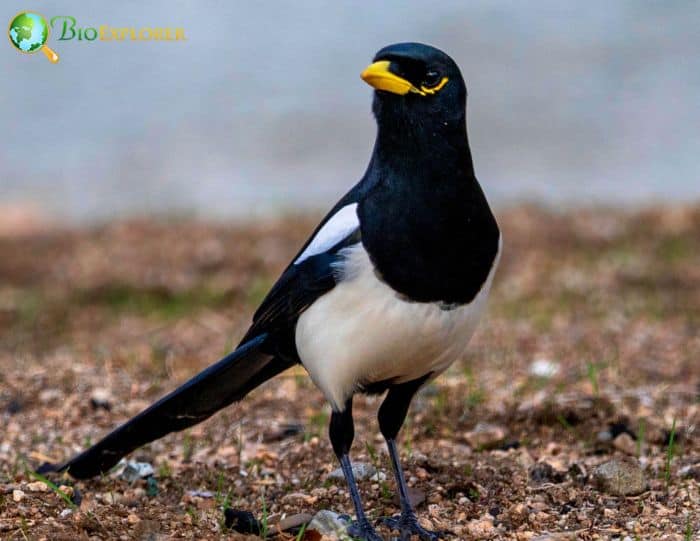
Yellow-billed magpies are sociable birds that frequently congregate in sizable flocks to rest and roost together in the evening.
- While flocks during the breeding season are by nature smaller, flocks during the autumn and winter can number up to 750 birds or more[3].
- The intelligent and playful yellow-billed magpies may play amusing games to hone their foraging abilities.
- While ornithologists are still learning about this behavior, it may warn other birds about dangers or fatal conditions.
- When one bird dies, the rest of its closely associated flock usually gathers nearby and displays mourning or funeral behavior.
Yellow-billed Magpie mate for life
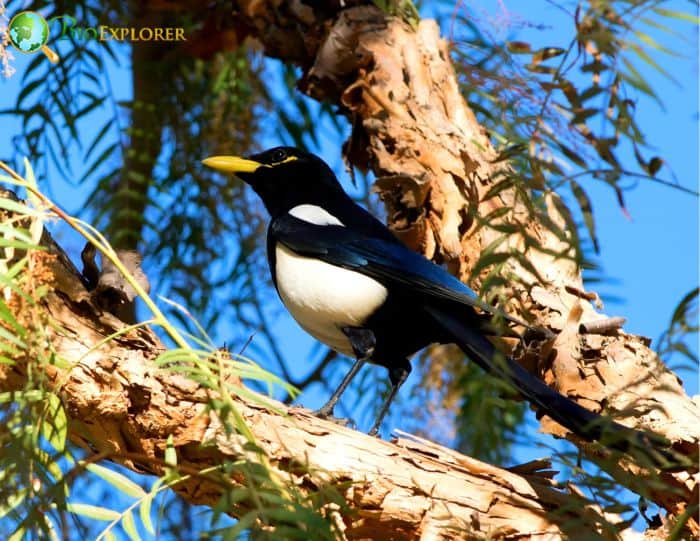
These black birds are monogamous and may stay together forever.
- Besides showing females they can feed their nesting partners by bringing them food, male yellow-billed magpies also strut before them to flaunt their strength and health.
- These loosely colonial birds will construct a sizable, bulky nest as a dome in a tall tree, 40 to 60 feet above the ground.
- Together, the parents construct the nest out of sticks, twigs, and mud and line it with more delicate components like fur, hair, rootlets, and grasses.
- There could be as few birds in a nesting colony or as many as 25 to 30 pairs.
Yellow-billed Magpie nesting habits
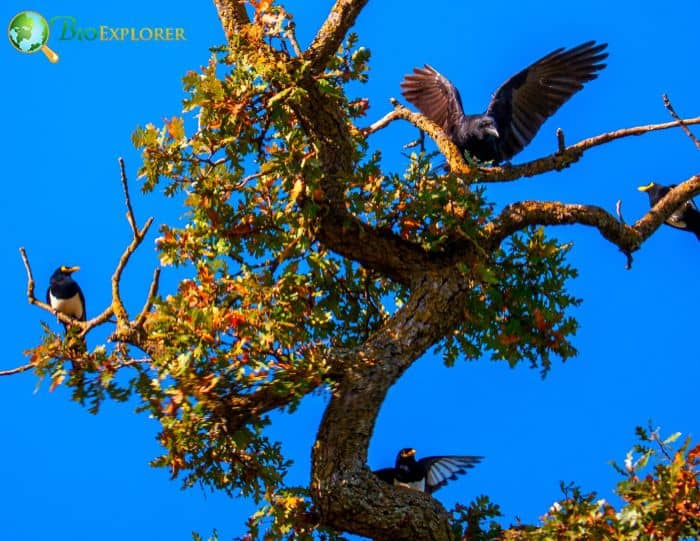
Even though most nests are built in trees, with no suitable trees, they will build on the ground.
- Nest is frequently protected by a roof and made easier by having two entrances[4]. Old magpie nests are frequently adopted by long-eared owls.
- Communal winter roosts can contain up to 200 birds and break up before dawn. Nest Tree sexes appear to choose a nesting site together before constructing individual nests in various locations.
- Conifer trees, shrubs, utility poles, and even abandoned buildings have been used to construct their dome nests.
- They build their nests in open forests, agrarian fields, riparian thickets, and suburbs. Magpie pairs construct rounded nests, which can be between 20 and 30 inches wide.
Yellow-billed Magpie Fun Facts
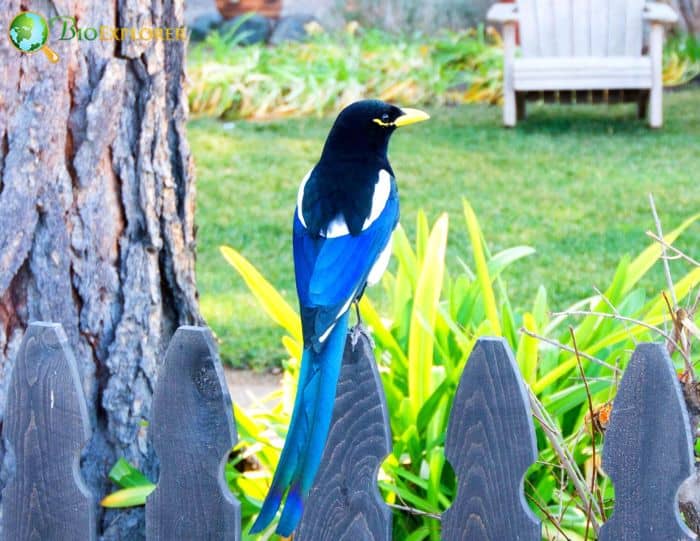
- The Yellow-billed Magpie is a boisterous bird that lives exclusively in California, nowhere else in the world. It is found in the Central Valley, the Coast Ranges, and the Sierra Nevada foothills.
- The species is gregarious throughout the year, even when nesting. Dozens of pairs sometimes nest close to each other.
- The Yellow-billed Magpie has been hit hard by habitat loss and the West Nile virus and is on the Partners in Flight Yellow Watch List for species with restricted ranges[5].
- The bird was named “Corvus nutalli” in 1837 by John James Audubon in honor of fellow naturalist Thomas Nuttall, who collected early specimens near Santa Barbara, California. (Check out all Corvus species here.
- Yellow-billed Magpies have been observed pecking insects off the backs of mule deer.
- The Yellow-billed Magpie makes a domelike, covered nest that requires maintenance throughout the nesting season. Pairs usually build a new nest each year, but they may refurbish an old nest late in the breeding season rather than build a new one.
- The oldest recorded Yellow-billed Magpie was a female at least 9 years, 11 months old when she was found in California.
- The Yellow-billed Magpie lives only in California, about 500 miles from north to south and less than 150 miles wide. Within this limited region, Yellow-billed nest in colonies in groves of tall trees.
- The Yellow-billed Magpie’s diet varies with the season, but year-round may average about 30% plant and 70% animal material (mainly insects). They may feed heavily on acorns in fall and winter, cracking them open by pounding with their bill; they also eat carrion in winter. They eat many grasshoppers in late summer.
- The Yellow-billed Magpie nests in small colonies. Pair formation may begin in fall, although birds remain in flocks during winter. The nest is a bulky domed structure (2-3′ in diameter) with an entrance on the side made of sticks and twigs. The nest’s interior has a base usually made of mud lined with fine plant materials[6].
Suggested Reading:
What Do Orioles Eat? Explore Oriole Diets, Hunting & Eating Habits
Frequently Asked Questions
What is the Yellow-billed Magpie, and what is its scientific name?
The Yellow-billed Magpie, scientifically known as Pica nuttalli, is a distinctive North American bird that lives in California. It’s a highly social, black-and-white bird with a bright yellow bill and a long tail.
Where can pica nuttalli be found?
Pica nuttalli, the Yellow-billed Magpie, lives in California and nowhere else. Its habitat is primarily in California’s Central Valley and oak savanna along streams, but it also forages in grasslands and open areas.
How can we recognize a Yellow billed Magpie?
The Yellow-billed Magpie is a riot of black and white with a bright yellow bill. It also has a characteristically long tail and is often found in open areas.
What is the diet of the North American Pica nuttalli?
Why is the Yellow billed Magpie on the IUCN Red List of Threatened Species?
The Yellow-billed Magpie, or Pica nuttalli, is considered a bird of concern due to a dramatic population decline over the past few decades. As per the IUCN redlist classification, yellow-billed magpie is now considered Vulnerable. Primarily, loss of habitat and disease are responsible for their limited range.
What kind of habitat does the Pica nuttalli prefer?
The Pica nuttalli or Yellow billed Magpie, prefers open areas, which include oak savannas, ranches, pastures, and fields. They can often be seen along streams or in California’s Central Valley.
How does the Yellow billed Magpie behave?
The Yellow billed Magpie is a highly social bird who lives in large groups. They also have a tendency to store food, retrieving it later when food supplies are low.
Is there a particular breeding season for the North American Yellow billed Magpie?
Yes, Yellow-billed Magpies usually breed between March and July. They are monogamous and breed once a year.
How often does the Pica nuttalli reproduce, and what their nests look like?
Pica nuttalli, the Yellow billed Magpie, reproduces once a year. The nests are built high in trees and are substantial structures of sticks and twigs, lined inside with fine plant materials.
Is the Yellow billed Magpie the only bird in the crow family unique to North America?
Yes, the Yellow billed Magpie is the only corvid, or bird in the crow family, endemic to North America. More specifically, it is found only in California.


